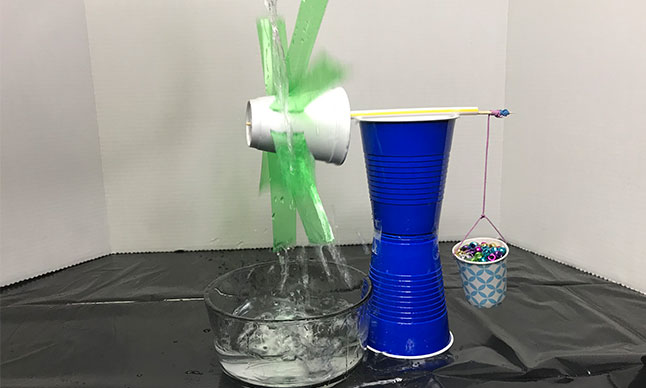Build a Hydro Power Machine
Use the force of falling water to lift up small items
- All
- Things to Make
- Experiments

What you’ll need:
- 1 Styrofoam cup
- Scissors
- A skewer or thin straw*
- A 750 ml plastic water bottle
- Tape
- Glue
- 2 large plastic cups
- 1 large straw
- 1 small paper cup
- String
- Various small items, such as coins or beads
- A rubber band
- A cup of water
*Choose something significantly longer than the Styrofoam cup and thinner than the large straw. It needs to be able to spin freely within the straw.

Activity setup:
- In the middle of one side of the Styrofoam cup, slice a 2.5-cm slit perpendicular to the opening. Add another slit of equal size about 2.25 cm beside the first one. Repeat this, moving around the cup, until you have 8 slits spaced equally apart.
- Poke a skewer or a thin straw through the bottom of the cup as close to the centre as possible. This will be your turbine's driveshaft. It should be sticking out of the cup.
- Ask a grownup for help with this step. Cut off the top and bottom of a regular plastic water bottle. Then, cut 8 strips measuring about 11.5 cm long and 2.5 cm wide from the side of the bottle. These will be your turbine blades.
- Feed one turbine blade (plastic strip) through a slit in your Styrofoam cup and glue it to the skewer inside the cup. Repeat this with the other 7 blades and slits. Set the Styrofoam cup aside for now.
- Stack two large plastic cups with their bottoms facing each other. Tape or glue the cups together.
- Cut a large straw to a length of about 11.5 cm. Tape the shortened straw across the opening of one of the stacked cups. Place the stacked cups aside for now.
- Ask a grownup for help with this step. Take a small paper cup and poke 2 holes opposite each other in the sides of the cup near the opening.
- Cut a piece of string measuring at least 40 cm and feed it through the holes in the paper cup. Pull the two sides of the string over the opening of the cup and tie them together to create a handle a few centimetres from the opening. There should be a long section of leftover string stemming from the top of the handle.
- Place a few small items, such as coins or beads, into the paper cup. Put the paper cup aside for now.
- It's time to assemble your machine! Grab your stacked cups—the straw-side should be on top. Then, turn your Styrofoam cup on its side and place the attached driveshaft (the skewer or thin straw) inside the large straw taped to the stacked cups. The driveshaft should be sticking out at the opposite end of the straw.
- Now, grab your paper cup. Tie the free end of the handle string to the end of the driveshaft sticking out at the outer end of the straw.
- Wrap a rubber band around the end of the driveshaft closest to the string to prevent the string from falling off while spinning.
- Place the device in a large bucket, a container or your sink. Carefully pour water onto the turbine blades sticking out from the Styrofoam cup. Watch as the turbine lifts the paper cup bucket!
Note: Be careful when testing the amount of water needed to spin the turbine. If you add too much water too quickly, it might break the blades or spin the driveshaft too quickly.
Try this!
Create a new turbine using different sized blades or a different material, such as plastic spoons, or try increasing or decreasing the number of blades. Did your modifications improve the machine?
Add more items to the paper cup to see how much weight the machine can lift! Another thing you can try is hanging the paper cup over the edge of a table with a longer piece of string. Remember to record your modifications and results!

How does it work?
Gravity causes the water to fall onto the turbine blades, which then causes the turbine to spin. The attached skewer acts as a driveshaft. When it rotates, the string wraps around it, lifting up the paper cup.
Hydroelectric power plants use the potential energy from falling water to generate electricity. At the top of a waterfall or a manmade damn, water flows into an intake to enter the power plant. Then, it travels downwards along a sloping tube called a penstock. This journey transforms the potential energy from the top of the fall into kinetic energy.
The water reaches and pushes the blade of a turbine located at the bottom of the penstock. The turbine blades are attached to a rotor and driveshaft—just like your Styrofoam cup and skewer or thin straw—which then spin a generator that contains magnets and metal coils. The spinning of the generator produces high voltage electricity.
This electrical current travels through transmission lines to a transformer, which lowers the voltage of the current so that it can be safely used in our homes.